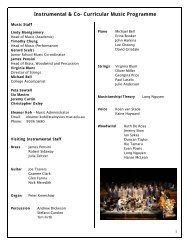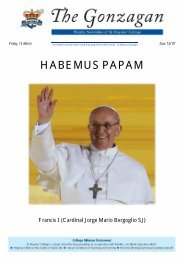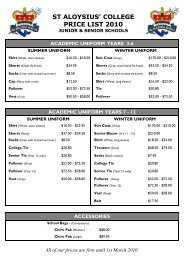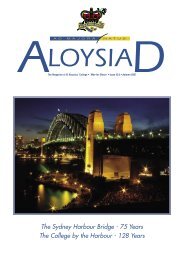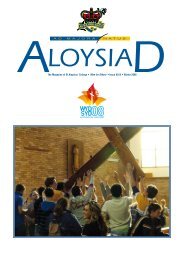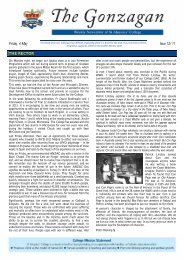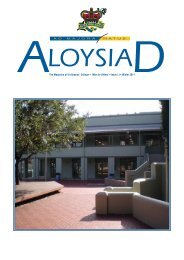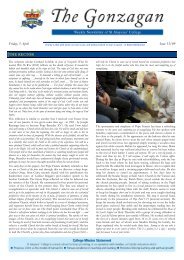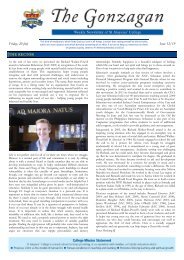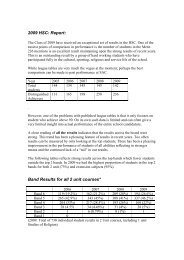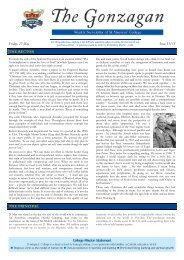Aloysiad 15-12 2006.indd - St Aloysius
Aloysiad 15-12 2006.indd - St Aloysius
Aloysiad 15-12 2006.indd - St Aloysius
You also want an ePaper? Increase the reach of your titles
YUMPU automatically turns print PDFs into web optimized ePapers that Google loves.
from the rector<br />
Entering the foyer outside The Great Hall, one passes by<br />
a number of honour boards which record the various<br />
Duxes, Presidents, Captains, School Heads, and the<br />
like, over this College’s one hundred and twenty seven year<br />
history. It is an impressive record. In recent years we have<br />
had Gap <strong>St</strong>udents working here from the Jesuit boarding<br />
school in England, <strong>St</strong>onyhurst College. It is a little older than<br />
<strong>St</strong> <strong>Aloysius</strong>’, having its beginnings four hundred and fourteen<br />
years ago! I recall once visiting it, and being impressed with<br />
just two honour boards which were displayed at the school’s<br />
entrance. One listed Old Boys who had been awarded the<br />
Victoria Cross. There were seven names there. Adjacent to<br />
this was a list of Old Boy martyrs and Old Boy saints. There<br />
were twenty two Old Boys who died for their faith. Seven<br />
are Blesseds, three are canonised Saints.<br />
I wondered what it would be like to have a martyr in<br />
the <strong>Aloysius</strong>’ family. One who was prepared to surrender<br />
their life for what they believed in. Then a couple of months<br />
ago, Fr Michael Head SJ, whom many readers would<br />
remember with affection as a former teacher at <strong>St</strong> <strong>Aloysius</strong>’,<br />
wrote to me. He is now in charge of the Jesuit Archives in<br />
Melbourne, where all our ancient letters and documents<br />
are housed. To my surprise and great delight, his letter<br />
informed me that he discovered we did, indeed, have our<br />
own martyr.<br />
Fr Vicente Guimerá SJ was a Spanish Jesuit. He was<br />
trained as a Physics and Chemistry teacher, and first worked<br />
in Jesuit schools and colleges in Spain and the Philippines.<br />
In the 1920s, Fr Guimerá was sent to a plantation in New<br />
Guinea, to help find a solution to some territorial problems<br />
after German missionaries had left New Guinea following<br />
the First World War. He then came to Sydney where he<br />
lived and taught here at <strong>St</strong> <strong>Aloysius</strong>’ during<br />
1924 and 1925. We have few records<br />
of his ministry here, only that he was<br />
much liked by all, taught classes,<br />
did local work as a priest, and<br />
was recovering from malaria during<br />
some of the time.<br />
<strong>St</strong> <strong>Aloysius</strong>’ College<br />
A Jesuit School for Boys _ Founded 1879<br />
Returning to Spain, Fr Guimerá<br />
was put in charge of fund-raising<br />
for the Missions in Micronesia<br />
– the same place where two of our<br />
graduating Year <strong>12</strong> boys<br />
now serve each year<br />
for twelve months. Fr<br />
Guimerá must have made<br />
some journeys himself to<br />
Micronesia, because<br />
the National Library in<br />
Canberra contains<br />
some works of<br />
his describing the<br />
islands and their<br />
customs.<br />
In 1935, due to<br />
the Civil War in Spain, his Mission Office was transferred<br />
to Belgium. But when religious persecution began in Spain,<br />
he wanted to return to his home country. He knew there was<br />
an increasing need by the people for priests to minister to<br />
them. He knew God’s Word must be preached. He also<br />
knew the dangers. Typically, each day he would say Mass<br />
in one place, eat in a second and sleep in a third house,<br />
so as to avoid arrest. As the persecution strengthened he<br />
moved to the house of his brother. Soon he was joined by<br />
his sister, a nun who had been expelled by the Republicans<br />
from the College in which she taught.<br />
The concluding lines of a letter written to Fr Austin Kelly SJ at the<br />
College on a tiny piece of paper, less than a year before Fr Guimerá’s<br />
martyrdom.<br />
Things in Spain are running behind: we are separated again and<br />
without seeing any precise light on the horizon. Pray for us.<br />
I came back to the Aragon Province a month ago. Here, we work a lot:<br />
help us with your prayers.<br />
Pass on my salutations to the Fathers I know.<br />
Yours in Christ<br />
Vicente Guimerá, SJ<br />
Because of the perils of being a priest, he was given<br />
money to buy ordinary clothing. But shortly afterwards, the<br />
house in which he lived was raided by the police. Vicente<br />
and his brother were taken into custody. People brought<br />
him food and blankets in prison, but it is said he gave them<br />
away to sick and dying prisoners.<br />
Vicente was executed by firing squad on 30 September<br />
1936 by the Republican forces. One hundred and twentytwo<br />
Jesuits were martyred in that war. The first day of our last<br />
holidays was the seventieth anniversary of his death. He<br />
was sixty-seven years old. The morning after the execution<br />
one hundred and five bodies were found and, though a list<br />
of them was taken, no attempt was made to identify where<br />
they were buried two days later.<br />
So why now remember a man long-dead? Why hail<br />
a martyr? Why bother with such an old tale from the<br />
College? Because this school draws strength and identity<br />
from its traditions, and in its history. It shapes who we are. It<br />
constantly reminds us of values worth holding on to. Vicente<br />
a l o y s i a d / p a g e 2




